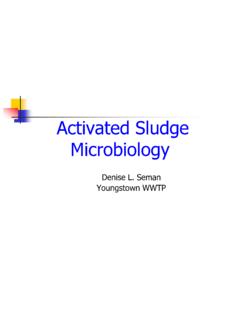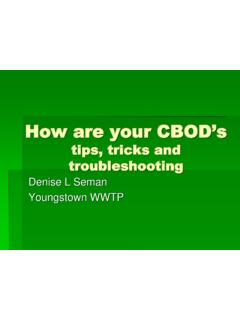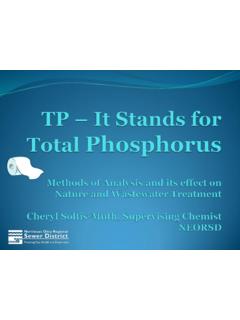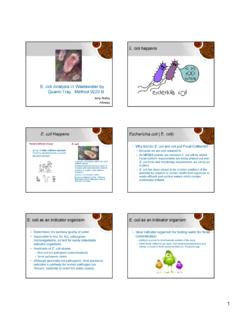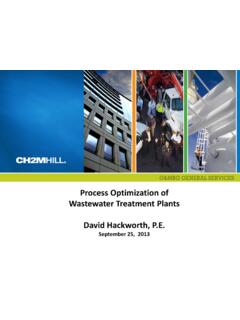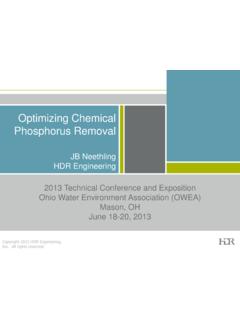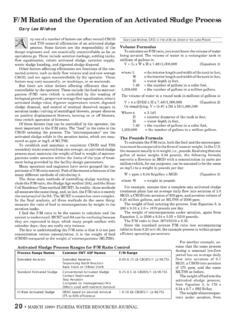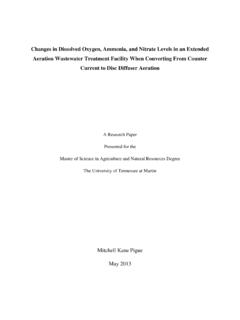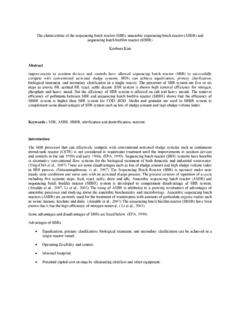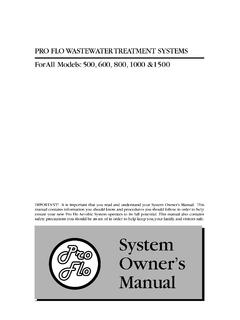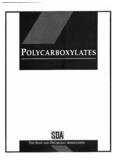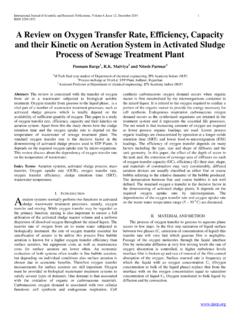Transcription of Where Activated Sludge Design Meets Operations
1 Where Activated Sludge Design Meets Operations : Plant Operations and Laboratory Analysis Workshop | Columbus, Ohio September 28 | 2011 MLSS = (SRT/HRT)[ISSin + Yg(BODin BODout)/(1 + b SRT)] by Eric J. Wahlberg Bridging the gap between engineers and What I have concluded: A most difficult bridge to gap But that s okay because the bugs are smarter than the engineers and operators In the beginning .. 2 A properly designed Activated Sludge system is flexible, reliable, and controllable 3 Good news: Minor operational changes can be implemented to accommodate changes in influent characteristics and/or effluent requirements. That s good news and bad news Bad news: Minor operational changes can result in changes in Sludge and effluent quality.
2 Brown and Caldwell | Footer | Date 4 One of my most favorite soapboxes. Raising the bar by embracing the math and science of wastewater treatment and process engineering fundamentals. Example: I wish I had $ for every time someone has told me, You can t use an equation in a presentation to operators. So there it is in my title, the most important equation an Activated Sludge plant operator will ever know. Plant attendants versus water quality professionals 5 Where Activated Sludge Design Meets Operations : Plant Operations and Laboratory Analysis Workshop | Columbus, Ohio September 28 | 2011 MLSS = (SRT/HRT)[ISSin + Yg(BODin BODout)/(1 + b SRT)] MLSS = (ISSin + Yg ) The equation big and bold 7 SRT HRT BODin BODout 1 + b SRT MLSS = mixed liquor suspended solids conc.
3 SRT = solids residence time HRT = hydraulic residence time MLSS = (ISSin + Yg ) The equation big and bold 8 SRT HRT BODin BODout 1 + b SRT ISSin = influent inorganic suspended solids conc. Yg = yield b = decay coefficient MLSS = (ISSin + Yg ) The equation big and bold 9 SRT HRT BODin BODout 1 + b SRT BODin = influent BOD concentration BODout = effluent BOD concentration MLSS = (ISSin + Yg ) This is the equation engineers use to Design Activated Sludge plants 10 SRT HRT BODin BODout 1 + b SRT If you remember nothing else of my talk today, know this.
4 11 The MLSS concentration is a response variable, not a control variable MLSS = (ISSin + Yg ) SRT HRT BODin BODout 1 + b SRT The equation does NOT include TSSin What s up with that? 12 MLSS = (ISSin + Yg ) SRT HRT BODin BODout 1 + b SRT The TSS coming down the pipe at us are organic ( , VSS) or inorganic ( , ISS) 13 TSSorg TSSinorg The BOD coming down the pipe at us is either soluble or particulate 14 TSSorg TSSinorg sBOD pBOD For purposes of our discussion, TSSorg (VSS)
5 Is same material as pBOD 15 TSSorg TSSinorg sBOD pBOD So it s only these three in the influent we really need to care about 16 TSSorg TSSinorg sBOD pBOD The particulate BOD is either settleable (pBODset) or not (pBODnon) 17 TSSorg TSSinorg sBOD pBOD pBODnon pBODset sBOD Primary clarifiers remove most of pBODset, TSSinorg, and floatables 18 TSSorg TSSinorg sBOD pBOD pBODnon pBODset sBOD pBODset TSSinorg sBOD pBODnon Primary effluent Primary Sludge Primary clarifiers aren t perfect so some of what shouldn t escapes Primary effluent sBOD pBODnon Escaping pBODset Escaping TSSinorg BODin With primary clarifiers.
6 This is the BODin of our equation Primary effluent BODout is not what you think it is 21 MLSS = (ISSin + Yg ) SRT HRT BODin BODout 1 + b SRT It is not the secondary clarifier effluent total BOD 22 Measure soluble BOD concentration here X sBOD test on exiting mixed liquor an indispensible process control test Procedure: mixed liquor sample at aeration basin exit. filter it as if to do a MLSS analysis. BODout in filtrate. it often as it is only true measurement of the efficiency of influent BOD conversion to biomass that occurs in the aeration basin. 23 Expressed in units of mass of biomass produced per mass of BOD removed ( , mg MLVSS/mg BOD removed).
7 Yield quantifies the fact that biological treatment Activated Sludge in this case is more a process of organic carbon conversion than removal. This term is affected by several factors, one of which is temperature. This primary effluent is flowing to conventional Activated Sludge Yield Yg 24 Hydraulic residence time HRT 25 A lot of operators (and engineers) have this wrong. Most agree that the system HRT=Vsystem/Q. Since the volume of the system is Vab + Vsc: HRT = (Vab + Vsc)/Q, which is HRT = (Vab/Q) + (Vsc/Q) Where Vab/Q is the HRT of the aeration basin. Not Vab/(Q + QRAS). RAS flow (QRAS) does not affect the HRT but does affect treatment.
8 A little 26 Minimal effect of QRAS on BOD removal. Plug-flow reactors have kinetic advantage over completely mixed reactors. Increasing QRAS increases the completely mixed characteristics in the aeration basin thereby decreasing extent of BOD conversion. Increasing complete mix, increasing QRAS Substituting HRT=Vab/Q into the equation gives 27 MLSS = (ISSin + Yg ) SRT Q Vab BODin BODout 1 + b SRT What is in the operator s control? 28 MLSS = (ISSin + Yg ) SRT Q Vab BODin BODout 1 + b SRT SRT yes Q some with flow equa-lization, otherwise no Vab yes in plants with multiple aeration basins, otherwise no ISSin no Yg no BODin no BODout this is what we re really trying to control but it is what it is b no Conclusion.
9 MLSS is controlled by SRT and, to some extent, aeration basin volume Notice I didn t list the MLSS concentration because it is fixed by the other variables 29 MLSS = (ISSin + Yg ) SRT Q Vab BODin BODout 1 + b SRT SRT yes Q some with flow equa-lization, otherwise no Vab yes in plants with multiple aeration basins, otherwise no ISSin no Yg no BODin no BODout this is what we re really trying to control but it is what it is b no Conclusion: MLSS is controlled by SRT and, to some extent, aeration basin volume But MLSS is important 30 MLSS = (ISSin + Yg ) SRT Q Vab BODin BODout 1 + b SRT MLSS too high high solids loading rate on secondary clarifier limits capacity and may lead to poor performance MLSS too low solids don t settle in distinct interface leaving stragglers What to do?
10 Rearrangement shows mixed liquor mass calculation 31 MLSS Vab = SRT Q (ISSin + Yg ) BODin BODout 1 + b SRT A word about temperature Brown and Caldwell | Footer | Date MLSS = (ISSin + Yg ) SRT Q Vab BODin BODout 1 + b SRT Our equation, like MLSS, can be broken down into two parts: MLISS and MLVSS MLSS = (ISSin + Yg ) SRT Q Vab BODin BODout 1 + b SRT Our equation, like MLSS, can be broken down into two parts: MLISS and MLVSS 34 MLSS = (ISSin + Yg ) SRT Q Vab BODin BODout 1 + b SRT MLISS = SRT Q ISSin Vab MLVSS = SRT Q Yg BODin BODout Vab(1 + b SRT) The ISSin can be very important consider two plants MLISS = 225 mg/L Municipal plant: SRT=5 d; HRT=8 hr; ISSin=15 mg/L, then: MLISS = 2,250 mg/L Industrial plant: SRT=30 d; HRT=24 hr; ISSin=75 mg/L, then: The second part of our equation, the MLVSS part, can be rearranged.
